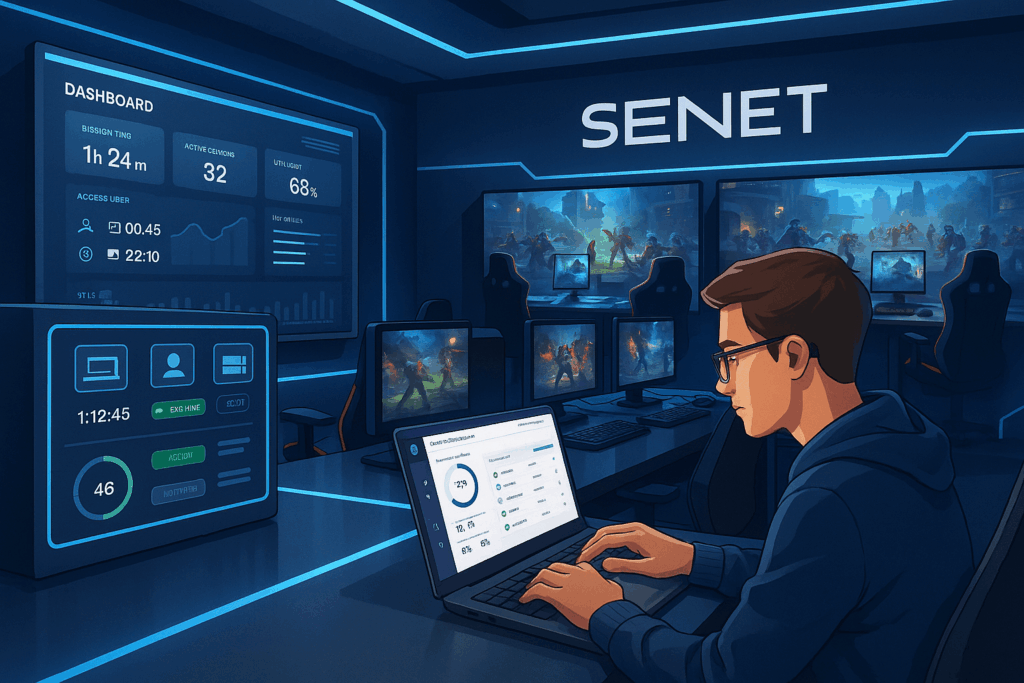Running a successful campus esports space today requires far more than just a few gaming PCs and fast internet. Whether it’s a competitive university arena or a modest high school gaming room, administrators face a new set of challenges: session control, data protection, fair access, real-time monitoring, and secure updates — all while providing a smooth experience to students.
This is where choosing the right esports software for schools becomes mission-critical.
From discussions with IT teams across colleges, universities, and high schools, one truth is clear: the software behind the scenes is what determines if your gaming lab thrives or fails. In this guide, we’ll break down the five essential features every esports management system should include, especially for institutions seeking to grow sustainable, secure, and scalable esports programs.
Feature #1: Centralized Session Control & User Management
The first must-have in any esports management platform is centralized control over user sessions. In an academic setting, you don’t want students monopolizing machines, installing games without permission, or disrupting lab schedules. That’s why real-time access control is non-negotiable.
🎮 Why It Matters:
- Ensures fair access for all students
- Prevents misuse of hardware or excessive gaming during class hours
- Allows staff to monitor session duration and idle time
🔧 What to Look For:
- Student logins using school credentials or single sign-on (SSO)
- Role-based access (e.g., admins, student assistants, guests)
- Timed sessions that automatically log users out
- Pause/resume options for academic interruptions
💡 Bonus: Systems like SENET allow for QR-code login, making it easy for students to hop into a session while maintaining traceability and session logs.
This feature bridges the gap between recreational use and computer lab control system discipline, enabling gaming to fit within academic boundaries.

Feature #2: Real-Time Monitoring and Performance Analytics
Educational institutions need more than just control — they need visibility. Esports labs are often used by dozens or even hundreds of students every week. Without real-time performance monitoring, it’s impossible to know which machines are overloaded, which licenses are underused, or how peak hours affect network traffic.
Esports software for schools should include built-in dashboards that show machine status, session durations, user activity, and system health. This helps IT administrators manage maintenance proactively and improve overall system efficiency.
Why it matters:
- Reduces downtime and technical issues by spotting them early
- Tracks lab utilization to justify budgets or request upgrades
- Identifies patterns in usage (e.g. heavy usage before competitions or exams)
What to look for:
- Machine-by-machine performance data (CPU/GPU usage, connectivity)
- Session reports grouped by user, time of day, or machine
- Alerts for overheating, idle systems, or unauthorized access
This kind of gaming lounge management is essential not only for operations, but for strategic planning. With good reporting, educators can also support grant applications, prove program value to stakeholders, and confidently plan hardware upgrades.
Feature #3: Automated Game Updates and System Maintenance
Managing dozens of machines manually is a nightmare — especially when each requires constant updates, patches, and installs. In an esports environment, where new games and patches are released weekly (or daily), this can drain IT resources fast.
That’s why any reliable esports software for schools must support centralized, automated updates — for both games and system tools. This not only ensures consistency across the lab but also helps avoid version conflicts during tournaments or classes.
Why it matters:
- Saves hours of manual labor for IT teams
- Prevents students from playing outdated versions
- Keeps the entire lab ready for competitive or academic use
What to look for:
- Centralized game library management
- Scheduled updates during off-hours
- Auto-sync with cloud repositories or Steam libraries
- Integration with system tools (antivirus, driver updates, etc.)
Platforms like SENET and other advanced computer lab control systems make it possible to manage updates across 10, 50, or even 100+ PCs with just a few clicks. No more sneaking into labs on weekends or late nights to install updates — the software does it for you.
Feature #4: Security, Compliance, and Access Restrictions
Universities and schools can’t afford to compromise on digital safety. Unlike public gaming cafés, educational institutions must follow strict compliance regulations, manage student data responsibly, and maintain clean, secure digital environments. That’s why security and access control are essential components of any esports management system.
This isn’t just about blocking inappropriate websites or preventing unauthorized software installs. It’s about ensuring that your gaming lounge management system meets internal IT policies, complies with academic standards, and protects both hardware and student data.
Why it matters:
- Protects against viruses, malicious downloads, and unauthorized apps
- Complies with data privacy regulations (like FERPA or GDPR)
- Keeps lab systems consistent, clean, and competition-ready
What to look for:
- Session-based system resets (auto-wipe all data after logout)
- Blocklists and allowlists for websites and applications
- Multi-level admin rights (for staff, student assistants, and general users)
- Centralized security settings pushed across all machines
A proper computer lab control system should allow IT to set usage limits, block game installs from unknown sources, and ensure every session starts on a fresh system — free from lingering files or exploits.
Feature #5: Academic Integration and Extracurricular Support
The best esports programs don’t stop at gameplay — they create opportunities for learning, leadership, and creative expression. That’s why the final must-have feature in any esports software for schools is the ability to support both structured academics and informal student-led activities.
Your esports lab isn’t just a place for gaming — it can be a lab for media production, a broadcasting studio, a digital marketing playground, or a training ground for IT support teams. The management system should reflect this multifunctionality.
Why it matters:
- Supports interdisciplinary learning (media, business, tech, health)
- Empowers students to lead events, build communities, and explore careers
- Increases retention by giving students meaningful roles on campus
What to look for:
- Scheduling tools for academic vs. recreational use
- Multi-user session modes for team projects or tournaments
- Compatibility with streaming software and content creation tools
- Integration with learning platforms or digital classrooms
Systems like SENET help schools manage these roles by allowing staff to create different access levels and time blocks — keeping labs open and flexible without losing oversight.
With these tools in place, universities can position their esports labs not just as entertainment spaces but as launchpads for 21st-century careers. Whether it’s gaming lounge management or skill development, the right platform turns passive screen time into active student success.
FAQ
1. What is esports software for schools?
It’s a management system designed for school-based gaming labs. It controls access, monitors usage, automates game updates, and ensures secure, fair operation of an academic esports environment.
2. How does gaming lounge management benefit schools?
It allows staff to manage PC sessions, enforce security, and maintain lab efficiency. It ensures students get equal access, and that gaming remains within academic guidelines.
3. What is a computer lab control system in esports?
It refers to tools that allow administrators to monitor, restrict, and automate actions in a digital lab. In esports, it’s critical for managing large groups of students, software versions, and time limits.
4. Can esports platforms support academics?
Yes. Top platforms offer scheduling tools, different permission levels, and compatibility with content creation tools, allowing labs to be used for both gaming and digital media coursework.
5. Is it possible to start an esports lab on a budget?
Yes. Schools can start small with 6–12 machines, repurposed space, and cloud-based software like SENET to reduce overhead and scale up over time.

